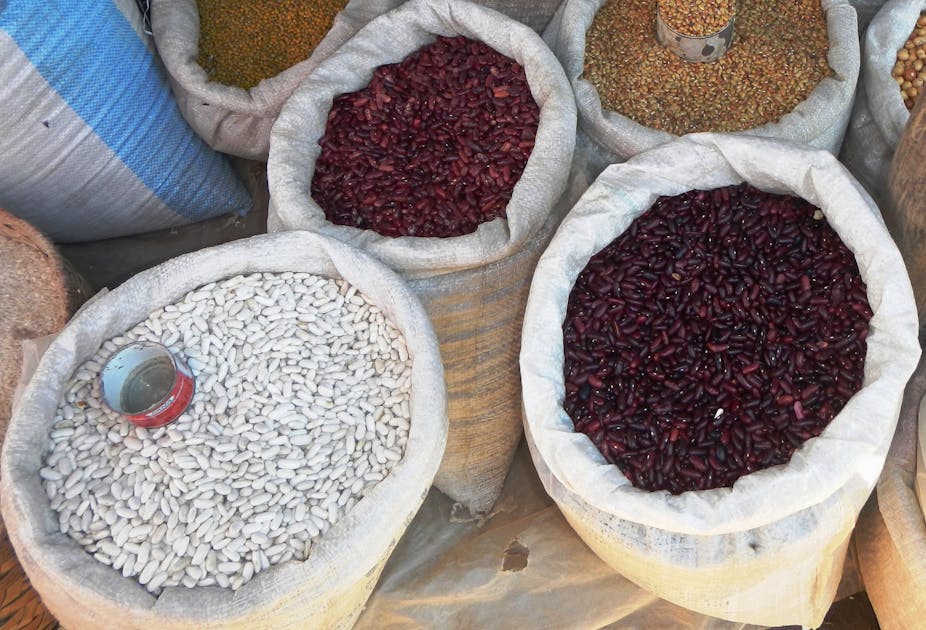African governments and donors have spent huge sums of money on seed systems. Simply put, seed systems are networks of organisations, individuals, and rules that produce and distribute seed. African governments, as well as donors, have invested in seed systems for decades, on the basis that these systems supply farmers with new crops varieties developed through research.
Up to now nearly all of this investment has supported the formal seed system which includes the state and private-sector organisations that operate under official regulations. Generally, such seed is officially certified to meet defined quality standards such as germination rates and purity. It is packaged and sold in commercial outlets like agro-dealers. Sometimes seed from this system is given away by aid programs.
Our paper shows that small-scale farmers get more than 90% of their seed from informal systems. This is seed saved after harvests, obtained from other farmers, or bought in local – often open – markets.
For delivering new crop varieties, the most common approach to informal seed systems has been benign neglect. There has been an assumption that once formal seed systems are established, farmers would increasingly seek their seeds from formal channels.
The problem is that they don’t.
Why the system doesn’t work for many farmers
In what may be the largest ever study of seed transactions, we looked at almost 10,000 cases across Kenya, Malawi, Zimbabwe, the Democratic Republic of the Congo, South Sudan and Haiti. We found that small farmers obtained only 2% of their seed from agro-dealer shops. Another 7% got theirs from government, the UN or NGO aid.
Farmers got the other 90% from informal systems. There were many in the field who knew this anecdotally. But the size and scope – more than 40 crops – of our study makes the significance of the informal system hard to ignore.
This does not mean that the formal agro-dealer shops are failures. It is simply that they have a niche focus. Their limitations include the fact that they:
supply only a few crops like maize and vegetable packets;
are located in towns; and
tend to be patronised by farmers with enough cash to buy seed packets larger than 5kg.
Farmers who live far from towns, who want a crop other than maize, or who don’t want – or can’t afford – large packs of certified seed are currently less well-served.
This is a tragedy, as these farmers could benefit from have more choice and access to many innovations. For example, legumes like beans or cowpeas can improve nutrition and enrich soils. Stress-tolerant crops can help cope with difficult climates. New varieties exist that could help, but they need to reach small farmers quickly and effectively.
The way forward
Thankfully, another key finding suggests a way forward.
Small farmers are buying more than half of their seed in the informal system, mainly from local markets and independent traders. For some crops, like grain legumes, two-thirds of seed is bought in local markets every year. This means that farmers can be an important customer group if the market actively serves them.
Seed sold in informal markets is rarely certified, except for vegetable packets. But farmers know and trust the vendors and often can get seed that meets their quality needs. These sources are preferred by many, particularly women, because they are accessible, reach remote areas, and offer a wider crop choice.
Farmers are interested in trying new crops and varieties, especially for grain legumes with traits that are useful. These include high protein, market value, or stress tolerance.
The fact that most farmers already buy seed points to opportunities to link them more effectively. The formal seed system could therefore do more to work with smallholder farmers as clients. Some initiatives that would make a difference include:
licensing outlets in more remote rural areas, like small retailers, which already sell to farmers;
introducing smaller packet sizes. These would be more affordable and could encourage farmers to try out new varieties;
improve two-way communication with small farmers to provide them information;
seek real feedback on how new varieties performed for them;
make the informal sector, especially local markets, partners in research. Selected merchants could become channels for distributing new varieties, and get information such as where to get new varieties; and
seed laws should be broadened to recognise a wider range of seed vendors and quality standards. This could increase the diversity of seed producers and of crops targeted to small farmers. It is already happening in some countries, as with Quality Declared Seed in Zambia and Tanzania.
If the ultimate goal is giving farmers better access to try out new crop varieties, we need to move thinking and practice beyond formal and informal seed systems. Small farmers in remote areas may be best served by intermediate approaches that link seed systems – and link farmers to innovation – in new ways.
Louise Sperling, a senior technical advisor for Catholic Relief Services, featured as a co-author on the article.

